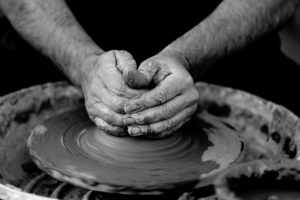History Behind Discovery of Ceramic Products
Remnants of primitive tribes presented as archeological evidence suggests that the earliest ceramic products were utilized by the Neolithic men. They utilized baskets as containers but they were not sufficient enough for containing liquids. This was when they felt a need for cheap material that was relatively lighter than stone. The importance of pottery was soon realized during the Neolithic age. Animal and human figurines dating back to 25,000 years ago were discovered in the Czech Republic.
Earliest examples can as well be traced back to The Middle East where agriculture is believed to have developed first. Pottery fragments dating back to 6500BC were found in Turkey. The wares comprised of coils or rings of clay built from a base that was circular. The walls were then thinned and smoothed before being fired in kilns.

The first potter’s wheel can be traced back to 3000BC. When a pot was built from the base it was impossible to achieve the perfect round shape. This problem was solved by the potter’s wheel and this is considered to be a crucial parameter in shaping the future of ceramics. The simple revolving wheel became part of the equipment used by the potter during 3000BC in Mesopotamia which is considered to be the cradle of many inventions.
The Greeks developed the sophisticated versions of early pottery during 5th century BC. They perfected the style of decoration. The vases developed were practical objects and were made in different shapes for storing olive oil as well as wine. During the 9th century BC, glazed ceramics became a technological breakthrough in Mesopotamia paving the way for the manufacture of decorative tiles. This was adapted for practical purposes centuries later.
Glazed pots came into existence in the Middle East during the 1st century BC. This kind of pottery became common in imperial Rome almost a century later. Glazed pottery as well became popular in the Han Dynasty of China. China and Rome were linked by the Silk Road and this led to the exchanges of attractive glazed commodities. Rich sequence of terracotta figures was also developed in Nigeria during the time.

During the 16th century, the first few examples of Porcelain reached Europe after the establishment of a trading port in Macao. The product was immediately appreciated as it was finer than any of the pottery offerings in Europe. This was when the term chinaware was coined. Attempts were made to create ceramics of this kind in Europe but the secrets of the Chinese were hard to discover. A lot of experiments were conducted for obtaining the translucent quality of porcelain. The result was the development of porcelain that was much softer.
China imports became much common during the 17th century. The idea of Europe’s tea drinking led to the increase in the use of delicate wares. Louis XIV granted privileges to potters for attempting to make perfect porcelain. This led to several developments such as bone china ware. This further paved a way for lot of developments in the field of ceramics.
